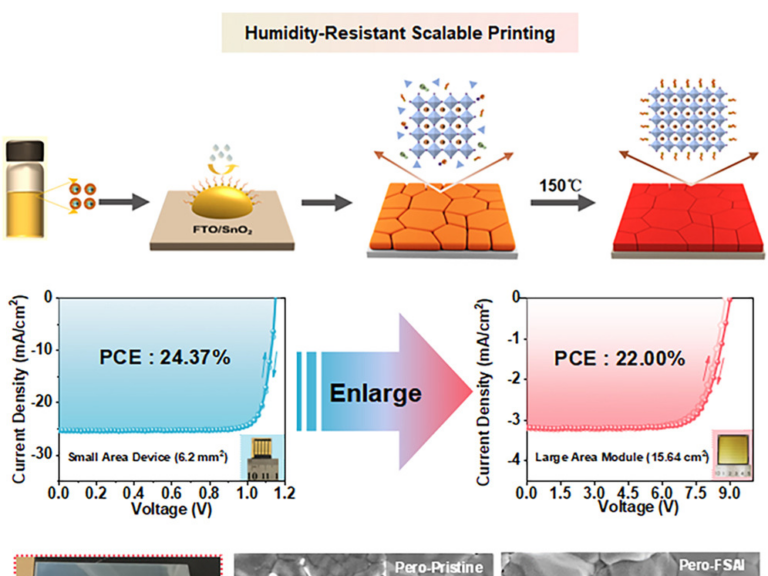Chen, X., Yang, F., Yuan, L., Huang, S., Gu, H., Wu, X., Shen, Y., Chen, Y., Li, N., Egelhaaf, H.-J., Brabec, C.J., Zhang, R., Gao, F., Li, Y., Li, Y.
Joule 8, 2265–2282, 2024
High-quality phase-pure formamidinium lead triiodide (FAPbI3) perovskite film needs to be fabricated under strict control of the surrounding atmosphere, which becomes more rigorous when large-area FAPbI 3 film is involved, leading to high-performance FAPbI3 perovskite solar cells and modules predominantly carried out in an inert gas-filled atmosphere. In this work, we propose a scalable printing strategy for the large-area high-quality phase-pure FAPbI3 film under a high-humidity atmosphere (up to 75% +/- 5% relative humidity) by regulating the perovskite precursor ink with a functional perfluoroalkylsulfonyl quaternary ammonium iodide. This approach decreases the energy barriers of cubic phase formation and heterogeneous nucleation, thereby regulating the FAPbI3 crystallization. The printed photovoltaic small-area cells and large-area modules achieved remarkable power conversion efficiencies of 24.37% and 22.00%, respectively. Specifically, the unencapsulated device exhibits superior operational stability with T90 > 1,060 h, ambient stability with T90 > 2,020 h, and thermal stability with T90 > 2,350 h

Chen, X., Yang, F., Yuan, L., Huang, S., Gu, H., Wu, X., Shen, Y., Chen, Y., Li, N., Egelhaaf, H.-J., Brabec, C.J., Zhang, R., Gao, F., Li, Y., Li, Y.
Joule 8, 2265–2282, 2024
High-quality phase-pure formamidinium lead triiodide (FAPbI3) perovskite film needs to be fabricated under strict control of the surrounding atmosphere, which becomes more rigorous when large-area FAPbI 3 film is involved, leading to high-performance FAPbI3 perovskite solar cells and modules predominantly carried out in an inert gas-filled atmosphere. In this work, we propose a scalable printing strategy for the large-area high-quality phase-pure FAPbI3 film under a high-humidity atmosphere (up to 75% +/- 5% relative humidity) by regulating the perovskite precursor ink with a functional perfluoroalkylsulfonyl quaternary ammonium iodide. This approach decreases the energy barriers of cubic phase formation and heterogeneous nucleation, thereby regulating the FAPbI3 crystallization. The printed photovoltaic small-area cells and large-area modules achieved remarkable power conversion efficiencies of 24.37% and 22.00%, respectively. Specifically, the unencapsulated device exhibits superior operational stability with T90 > 1,060 h, ambient stability with T90 > 2,020 h, and thermal stability with T90 > 2,350 h